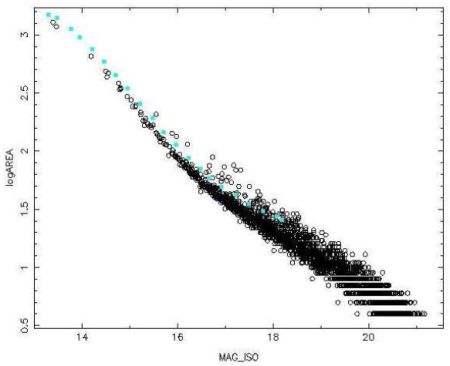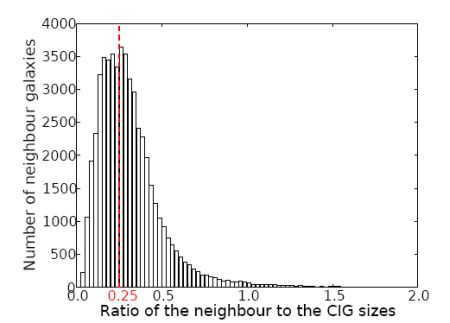Isolation
The AMIGA project adopted the Catalogue of Isolated Galaxies (CIG: Karachentseva 1973) as a starting point. In our previous works we identified several CIG galaxies failing Karachentseva’s criterion, hence motivating us to carefully revise the isolation of the CIG members. Hence we use this sample as a starting point to refine and perform a better quantification of its isolation properties.
A catalogue of neighbours around isolated galaxies based on POSS I & II images
Quantification of the isolation based on POSS I & II images
Revision of isolation using the SDSS
Effects of the environment on galaxies in the Catalogue of Isolated Galaxies: physical satellites and large scale structure
Catalogues of isolated galaxies, isolated pairs, and isolated triplets in the local Universe
The Catalogue of Isolated Galaxies
The catalogue is composed of 1051 objects with apparent Zwicky magnitude mzw brighter than 15.7 and declination > -3°. Karachentseva visually inspected the Palomar Sky Survey prints, trying to identify those galaxies in the Catalogue of Galaxies and Clusters of Galaxies (CGCG, Zwicky et al. 1968) which have no near similar size neighbours. Primary galaxies with angular diameter Dp are considered isolated if any neighbour with diameters Di (with Dp/4 ≤ Di ≤ 4Dp) has an apparent angular separation Rip, from the primary galaxy, greater than 20Di.
This criterion statistically implies that all possible effects of a past interaction on the morphological or dynamical properties of a CIG galaxy, or those concerning the enhancement of star formation processes, have likely been erased at the present time. Because this represents a lower limit on the time since the last interaction between a CIG galaxy and a potential neighbour, the CIG galaxies have apparently been isolated for much (if not all) of their existence. For instance, for a CIG galaxy with Dp = 3', no neighbour with Di = 12' may lie within 240' and no neighbour with Di = 0.'75 may lie within 15'. If one assumes an average Dp = 25 kpc for a CIG galaxy and a typical "field" velocity V = 150 km s-1 then an approximately equal mass perturber would require 3×109 years to traverse a distance of 20Di (Stocke 1978).
This is a conservative criterion in the sense that, since no redshift data is used for the isolation definition, a truly isolated galaxy may be excluded from the CIG due to a projected background/foreground neighbour: galaxies isolated in space do not necessarily appear isolated in the sky. As a result of these projection effects the CIG is not fully complete. Nevertheless, the sample is still reasonably complete, according to the Schmidt (1968) luminosity volume test which gives = 0.42 at a Zwicky magnitude of 15.0 (Huchra & Thuan 1977, Xu & Sulentic 1991, Toledo et al. 1999, Verdes-Montenegro et al. 2005). On the other hand all galaxies that are included should be isolated. The CIG is a sample of galaxies isolated from similarly sized neighbours, but it is clear that dwarf neighbours are not excluded.
The AMIGA revision
Various visual revisions have been performed by several authors, but we have chosen to improve Karachentseva’s sample by checking in an automated, homogeneous way the isolation of the galaxies and by listing/classifying the neighbour galaxies. We have excluded from our revision all the CIG galaxies with radial velocities lower than 1500 kms−1 (100 galaxies) since, as pointed out by Stocke (1978) and Haynes & Giovanelli (1984), the area searched for potential neighbours of nearby CIG galaxies is spread over a large surface on the sky, which makes the search overwhelming. Our final target sample is composed of 950 CIG galaxies.
We developed an original method to check the isolation of the CIG galaxies. Digitised POSS-I E images were analysed out to a minimum projected radius R ≥ 0.5 Mpc. We have assembled a software pipeline for producing star/galaxy catalogues in the area around each CIG field. We used SExtractor (Bertin & Arnouts 1996) to detect the sources in the images. The images were reduced using AIMTOOL in LMORPHO (Odewahn 1995, Odewahn et al. 1996, 2002), and a Graphical User Interface (GUI) driven star/galaxy separation procedure was used to classify detected sources as: STAR, GALAXY or UNKNOWN (for the faint, low resolution sources). Star/galaxy separation was performed in the log(area) vs. magnitude (SExtractor MAG ISO), which was found to robustly isolate the stellar locus brighter than MB ~ 17.5 in a random sample of Schmidt plates. A typical star/galaxy separation parameter plane from a POSS-I E image (CIG 714) is shown in Fig. 1.

Fig. 1 Star/galaxy separation parameter plane. The objects above the separation line (blue points) are classified as GALAXY, while the ones below are classified as STAR. The objects fainter than the extent of the separation line are not classified, their type is UNKNOWN.
The galaxies have a lower surface brightness than the stars and in the log(area) vs. magnitude plane, the two classes of objects fall in different loci (Leon et al. 2000). The stellar locus in log(area) vs. magnitude plane was manually located using an interactive GUI approach because the shape and location of this locus changes significantly on different POSS-I Schmidt plates. All the points that lie above the curve defined by the blue filled circles (which is described with a cubic spline) were classified as GALAXY. The points below this curve were classified as STAR. Points lying outside the spline range (brighter or fainter in magnitude than the extent of the red points) were classified as UNKNOWN. As a final step, we archived our catalogues in the form of ASCII files.
One of us (S. V.) systematically verified all the objects (GALAXY, STAR and UNKNOWN) and changed the types if needed. This task was very time consuming as the mean number of objects detected amounted to 4000 per single 55' × 55' field (up to 14 000 at low galactic latitude). Finally, we also used POSS-II red (IIIa-F) plates of all our GALAXY objects to perform a second check of our final catalogues of neighbours (55 154 stamps, visually checked by L. V.-M.)
Conclusions
We have performed a systematic study to list all the projected neighbours, down to a magnitude m ~ 17.5, lying within 0.5 Mpc around the CIG galaxies. Our conclusions are the following:
-
Using automated classification, some of the galaxies in the CIG appear not to be isolated according to Karachentseva’s original criterion. Nevertheless, this remains a valid sample as a starting point to obtain a refined sample of isolated galaxies.We give a first catalogue distinguishing the isolated CIG galaxies according to Karachentseva from those failing the original criterion: a systematic and visual inspection of the objects lead to about 54 000 neighbours.
-
We looked for the available redshifts of the neighbour galaxies in 12 databases: 30% have known velocities, and the neighbour galaxies represent statistically a background population, with respect to the CIG galaxies.
-
We identified some physical pairs and pair candidates. When a neighbour galaxy is found very near in projection from the central CIG galaxy, its probability of being a physical companion is high.
-
The factor 4 in size defined in the original criterion takes into account the majority of galaxies up to a velocity difference of 20 000 kms−1, which makes the CIG original criterion much more restrictive than commonly used criteria which use velocity differences of about 1000 kms−1.
In Fig. 2, we show the distribution of the size of the neighbour galaxies with respect to the size of the associated CIG galaxy. Very few neighbours have a diameter larger than the diameter of their associated CIG galaxy. The distribution increases exponentially as the diameters of the neighbours get smaller: the peak of the distribution is reached for the neighbours having diameters of about one fourth the size of the diameter of the associated CIG galaxy. This corresponds to the nominal factor used by Karachentseva: the sizes of the neighbours taken into account by Karachentseva’s isolation criterion are not equally distributed between 0.25 and 4Dp, the vast majority of the neighbours (about 88%) are at least two times smaller than their associated CIG galaxy.

Fig. 2 Distribution of the major axis of the neighbours with respect to the major axis of their associated CIG galaxy. The red dashed line represents the lower limit defined by Karachentseva to consider a neighbour as a potential perturber.
-
Criteria based on magnitude differences to select the neighbours are not fully consistent with Karachentseva’s criterion based on the linear sizes. The discrepancy arises from the fact that the surface brightness profile of galaxies is not flat, but nevertheless they are similar criteria to a first approximation.
-
A catalogue of the ~ 54 000 neighbour galaxies is available electronically at the CDS with positions, magnitudes, areas as well as redshifts when available.
 Verley et al. 2007a Verley et al. 2007a
|



 Verley et al. 2007a
Verley et al. 2007a
